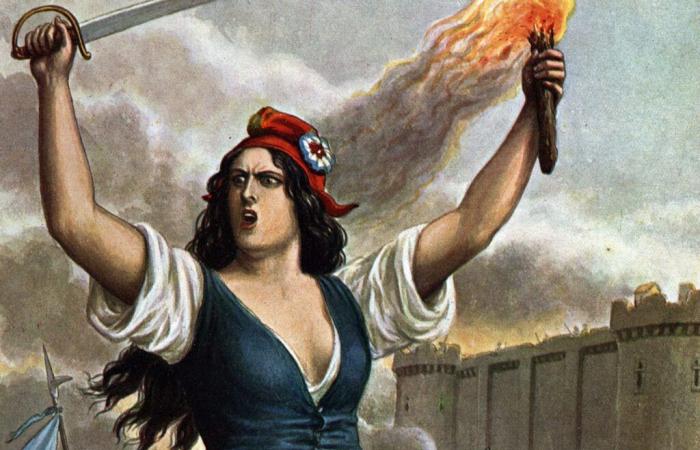The JDD. In Things seenVictor Hugo writes: “Let us leave history with its sublime lies”. These are the lies that you track down in your latest book, We needed myths, the Revolution and its imaginaries from 1789 to the present day. Myths, mind you, are “our tunic of Nessus” ; as a historian, you question them without respite. So, get started: “The Revolution would not have been what it is without the weight of Catholicism”. Isn’t the question of our secularism directly posed?
Emmanuel de Waresquiel. Right there. It is also fascinating from the point of view of heritage and our controversies about secularism today.
Was not a new, regenerated man, cut off from his (Christian) roots, called to see the light of day in 1789?
The rest after this ad
But it doesn’t work! Man cut off from his roots is the essence of all revolution. Except for the Hitlerian “revolution” which is, on the contrary, the construction of a genealogy of memory which will draw on the most ancient Germanic roots. In short, the Revolution takes place, from the point of view of sacredness, in a permanent tension between the weight of the Catholicism of the Ancien Régime which continues, good year after year – Corpus Christi is still celebrated in Paris in 1793 -, and the making of a regenerate man. The impregnation of ancient Catholic culture continues to deeply affect society; we will find this impregnation under the Empire and throughout the nineteenth century.
Yes, the Revolution would not have been what it was without this weight of Catholicism, starting with the rallying of the first order of the kingdom (the priests were the most numerous among the 600 deputies of the Third Estate), from the 19 and June 20, 1789. The Civil Constitution of the Clergy at its beginnings, contrary to what is said, before the Pope fulminated against it, was not unanimously accepted but majority accepted. Against a backdrop of Jansenism, there is a utopia, the dream of a return to a Catholicism of the catacombs, egalitarian, stripped of its gold and its ornaments, of Rousseauist inspiration.
And then, there are his inspirations from the Enlightenment, from the great watchmaker that we will find in the cult of the Supreme Being of Robespierre. So, in summary, there is this whole Catholic background with its metastases from the second half of the eighteenth century. The relics of the saints are protected by the people of Paris! It’s a sign.
“Of the 700 deputies of the Convention, one in ten is of clerical origin”
From the other side, if I dare say, from the revolutionary extreme left, it’s a completely different matter, isn’t it?
For the Hébertists, in fact, and many things can be explained by factional struggles between Robespierrists and Hébertists, there is a very clear desire for a secularism which would become a sort of state theology. Basically, we find these controversies today in the differences in our conceptions of secularism: that is, a secularism which would be conceived as a simple way of workinga rule of the game which would allow freedom of conscience and worship, or a much more totalizing secularism, which would become a state dogma, a dogma, as Victor Hugo says, without God and without a priest, a sort of reversed theocracy . These two conceptions of secularism clash, it is very topical and the problem is still not resolved!
Could you not have written that the Terror would not have been what it was without the weight of Catholicism?
Of the 700 deputies of La Convention, one in ten is of clerical origin.
Let’s demystify now: wasn’t the Palm Game Oath taken under the influence of fear?
At least, out of fear. We even go so far as to imagine, under the Directory, a battle of the Jeu de Paume. While the watch service of the Palace of Versailles had made itself available to the deputies of the Third Estate, which we somewhat forget to say.
Another myth, the Bastille. Was she captured on July 14, 1789, or did she surrender?
Against the backdrop of the anti-tax crisis, part of the people of Paris are rising up. Mainly the Saint-Antoine and Saint-Marcel suburbs. He attacks the barriers of Paris. He gets his hands on rifles stored at Les Invalides. He doesn’t see any resistance, moreover. The last regiments of the king who were camped at the Champ-de-Mars have left the capital. The uprising people have guns but no gunpowder. But we know that there are two or three hundred barrels of powder stored in one of the towers of the Bastille. So we are going to march on the Bastille not because it is the absolute symbol of royal tyranny, but because there is gunpowder. The prison was attacked but not taken — if we are to believe a certain number of contemporary accounts of the event.
“It is a question of comparing the two events of the Jeu de Paume Oath and the storming of the Bastille”
The Bastille was defended by around thirty unfortunate invalids and around fifty Swiss guards. Delaunay, the governor, was as military as I am pope. Panicked, after multiple confusing negotiations, he finally lowered the drawbridge and opened the doors. There is this terrible and absolutely wicked sentence from Rivarol: “Mr Delaunay had lost his head long before it was cut off”. In the days that followed, a heroic story was constructed which was that of the emergence of the triumphant, victorious, self-possessed, courageous and mature people onto the great stage of the French Revolution.
This involves comparing the two events of the Jeu de Paume Oath and the storming of the Bastille. They are founding in the way they were reinterpreted and antagonistic because from the point of view of revolutionary heritage, they will give rise to a double culture of political legitimacy which is very French. On the one hand, a legitimacy resulting from parliamentary representation as theorized by Sieyès, a legitimacy of the election and the ballot boxes; on the other, a legitimacy of direct democracy – I am using an anachronism here – which would be a legitimacy of the street and of the people.
This clash of these two legitimacies, this balance of power, made the Revolution until the Terror. The revolutionary days are the very illustration of this conflict of legitimacy. Hence our appetite for strikes… Think of the Yellow Vests… Legitimacy which is measured by the occupation of public space… De Gaulle claims a superior legitimacy which would be of the people against legality. Well, this is all disturbingly current.
We needed myths, The Revolution and its imaginaries from 1789 to the present day, by Emmanuel de Waresquiel, Tailandier, 445 p., 24, 60 €






